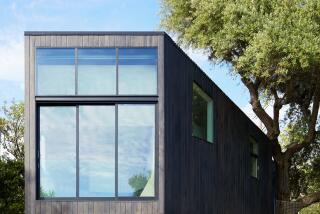Al Boeke dies at 88; ‘father’ of Northern California’s Sea Ranch
Al Boeke, the developer-architect whose vision spawned Sea Ranch, the sprawling Northern California coastal enclave known for elegantly rustic homes built to harmonize with a breathtaking natural landscape, died Nov. 8 at his home there. He was 88 and had liver cancer, said his wife, Pamela.
Stretching for 10 miles along the Sonoma County coast, Sea Ranch is widely considered one of the most important planned communities in the West from an architectural standpoint. To design the development and its structures, Boeke (pronounced bo-kay) engaged some of the most innovative architects of the latter 20th century, including Charles Moore, Joseph Esherick, Donlyn Lyndon, William Turnbull, Richard Whitaker and Lawrence Halprin, the landscape architect who drafted the Sea Ranch master plan.
Sea Ranch houses — light-filled, postmodern wood sheds — became icons of Northern California design mimicked around the world.
“Al Boeke was the father of the dream of the Sea Ranch,” Jer Skibbins, a former president of the Sea Ranch homeowners association, said in a statement last week.
Boeke first set eyes on the property in 1962 when he was a vice president of Oceanic California Inc., an entity of Dole Food Co.’s real estate division, Castle and Cooke. He had been scouting for land to build a planned city inspired by the European new-town movement, which aimed to provide an alternative to the congestion and pollution of large urban centers. He was already overseeing one such development in Hawaii called Mililani on the island of Oahu.
A real estate specialist took him up in a twin-engine Cessna to scope out the 5,000-acre Del Mar Ranch, then populated mostly by sheep. Boeke was stunned by the unspoiled coastal terrain, which encompassed magnificent stands of cypress, the winding Gualala River, sheer bluffs and grand panoramas of the Pacific. The pilot made only two or three circles over the property before Boeke announced, “I don’t want to look at anything else.”
Oceanic paid $2.3 million for the property — less than $500 per acre.
Boeke recognized a rare opportunity in the isolation and raw beauty of the area.
His idea was simple: “The basic notion,” he told architectural historian Kathryn Smith in a 2008 oral history for UC Berkeley, “is that we would respect the land. We would put people on the land in a way that they were inconspicuous. We would build architecture … that seemed natural in this place.”
He envisioned “a quiet, meditative community” for teachers, professors and other progressive-minded people — “not special folks, just folks,” he said. The master plan included condominiums that were priced within the means of the middle- and upper-middle income residents he sought.
What unfolded over the next decade was “not a textbook definition of a new town,” Smith said in an interview Friday. It would not have a grocery store, gas station or other amenities. It was an experiment of another kind, ahead of its time.
“He wasn’t a hippie,” Smith said. “But he wanted to build a residential community that fit this unparalleled natural site. He wanted to have it be a reflection of the natural ecology.”
Boeke, who was born in Denver on Nov. 20, 1922, grew up in Altadena and earned a degree in architecture from USC in 1948. Early in his career he worked for Richard Neutra, the Los Angeles Modernist architect.
He brought his progressive approach to Castle and Cooke, which hired him in 1959.
He persuaded its top executives that Sea Ranch should not be densely built but offer instead a small number of weekend homes that would keep the population low. “Minimal disruption” of the natural environment was a guiding principle, so houses had muted colors that blended with their surroundings, power lines were buried underground and roofs were slanted to cope with the fierce North Coast winds.
Houses would be allowed along the hedgerows and in the meadows but not in the areas directly fronting the coast.
“The dominant idea was making that whole coastal experience available to all the people who live here, not just to a front row of houses. That is not conventional development wisdom,” said Lyndon, a retired UC Berkeley architecture professor and member of the original design team, who lives at Sea Ranch.
Boeke conceived Sea Ranch the same year that “Silent Spring,” Rachel Carson’s groundbreaking expose of pesticides that launched the modern environmental movement, was published.
Ironically, the movement eventually turned against Sea Ranch, which critics portrayed as an outrageous encroachment on public access to a large swath of the state’s majestic coast. Battles to preserve the coast led to the creation of the California Coastal Commission in 1972, which succeeded in blocking construction at Sea Ranch for 10 years.
By the time the moratorium was lifted, expenses had risen so sharply that only the very wealthy could afford to build there, and they built large, luxurious homes that violated the original Sea Ranch philosophy. Sea Ranch was beyond the reach of the “just folks” Boeke had intended it for. It was a bitter turn for Boeke, who told Smith, “This isn’t any longer the Sea Ranch, as far as I’m concerned, and that’s a pretty rough statement.”
However, Smith noted that of the planned communities Boeke helped build, Sea Ranch remained his favorite.
In addition to his wife, Boeke is survived by two sons from a previous marriage, a brother, a sister and grandchildren.
More to Read
Start your day right
Sign up for Essential California for the L.A. Times biggest news, features and recommendations in your inbox six days a week.
You may occasionally receive promotional content from the Los Angeles Times.





















































